When you question out-of-towners about things to do in Shenyang, the first 2 sights they will probably come up with are the Imperial Palace and Commander Zhang’s Mansion. While our own small version of the Forbidden City is probably familiar to you, the second one might not be. Many foreigners have no clue about who Commander Zhang even is, let alone express a wish to see his house.
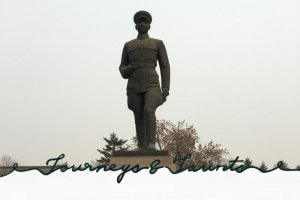
J&J, of course, is all about pushing the envelope, so that is why we bring you the less known sight of those two first. While the museum/landmark boasts a number of signs in (sometimes quite imaginative or ‘interesting’) English, knowing the back story of this sight and the people who lived here is helpful going in.
So, here goes:
What is Commander Zhang’s Mansion?
Commander Zhang’s Mansion (张氏帅府 in Chinese, zhāng shì shuài fǔ in pinyin) is sometimes also nicknamed 大帅府 (Big Commander’s Mansion) or 少帅府 (Young Commander’s Mansion) by the locals. In English, I have heard people call this landmark Commander, General, or even Marshal Zhang’s Mansion. Military ranks apparently don’t translate well…
Whatever you call it, the place was the private and official residence of two individuals who played a major role in Dongbei (Northeastern) politics and influenced the course of history of all of China. The first of these is Zhang Zuolin (张作霖 in Chinese, zhāng zuò lín in pinyin), the second one is his son Zhang Xueliang (张学良 in Chinese, zhāng xuéliáng in pinyin).
Construction of the buildings started in 1914, i.e. in year 3 of the Republic of China. The entire complex covers about 36,000 square meters, with four building areas. The first is a set of adjourning courtyards called 三进院 (sān jìn yuan in pinyin), which roughly translates to Three Entrance Buildings.

Then there is an area containing 大青楼 (dà qīng lóu in pinyin, meaning Big Blue-Green Building), 小青楼 (xiǎo qīng lóu in pinyin, meaning Small Blue-Green Building), 关帝庙 (guāndì miào in pinyin, God Guan Temple in English), as well as a garden area.

Outside this main enclosure, there is Ms. Zhao’s House (赵四小姐楼 in Chinese, zhào sì xiǎojiě lóu in pinyin), where the erstwhile mistress and later wife of Zhang Xueliang lived for a short while.

Then there is the Border Bank (边业银行 in Chinese, 边业银行 in pinyin), which belonged to 95% to the Zhang family, and now houses a finance museum.

And to the West, there is a grouping of red brick buildings called 西院红楼群 (xī yuàn hóng lóu qún in pinyin), which are not open to the public.

Commander Zhang’s Mansion is classified as an AAAA-level tourist attraction (the second-highest level of sights in the PRC). You pay an entrance fee to see it, but since the ticket covers the entire complex with its various exhibitions including the detailed finance museum in the Border Bank, I think it well worth the investment.
Zhang Zuolin’s story
Zhang Zuolin (1875-1928) – nicknamed the Old Marshal, 大帅in Chinese, dà shuài in pinyin – was an important figure in Chinese politics during the warlord era and the master of Manchuria from 1916 until his death in 1928. He invaded the heart of China in October 1924 during the Second Zhili-Fengtian War and gained control of the Chinese capital (then called Peking) in April 1926.

According to some sources, Zhang, who came from a poor family in Haicheng (modern Liaoning province, then Fengtian) was illiterate. What is undisputed is that he started his career as a bandit, rising through the ranks until he commanded his own army and became a major force in the political landscape of the time, and a warlord in his own right.
The fact that Zhang Zuolin was educated in the “University of the Green Forest” (an oblique reference to his bandit days) meant that he was not an accomplished manager, and probably one of the reasons he hopelessly overtaxed Manchuria and the economy broke down in the winter of 1927/28.
His army, then underequipped and understaffed, was defeated by the Nationalist Army under Chiang Kai-shek in May 1928. The Japanese then planted a bomb under a viaduct Zhang’s train passed through on its way back to Shenyang on June 4th, 1928. The blast severely hurt Zhang Zuolin and he died of his wounds. His passing away was hushed up for over two weeks, so that the official announcement of his death is June 21st, 1928.
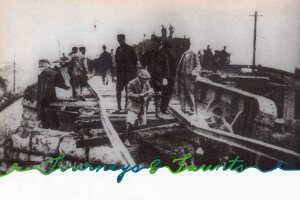
The Japanese were furious at their long-time ally Zhang, because he was unable to stop the Revolutionary Army and thought that if they killed him off, his son Zhang Xueliang (only 27 at the time) could be easier to manipulate and control.
Zhang Zuolin was a bandit at heart, and his personal fortune, started during his bandit days by plundering and thievery, at one time measured around 2.6 million USD. He also had 5 wives and many more mistresses, and the splendor of the mansion he built is proof that he liked to show off what was his.
Zhang Xueliang’s story
Zhang Xueliang (1901-2001) is the eldest son of Zhang Zuolin’s official (i.e. first) wife. His nickname is 小帅 (the Young Marshal). Which is ironic, if you ask me, since he lived to be just over 100.
But when Zhang Xueliang became the commander of his father’s army after the Huanggutun Incident (where Zhang Zuolin’s train was bombed), he was only 27, so I guess you could still call him the Young Marshal then, and the nickname just stuck.

Not much better than his father in the area of womanizing and being an opium addict to boot, the Japanese thought Zhang Xueliang would be no match for them. Must have been an unpleasant surprise when that useless playboy and druggie overcame his addiction and shaped up to be a successful leader of the army.
Zhang Xueliang was a staunch supporter of the Nationalist Movement and very close to Chiang Kai-shek. But he disagreed with Chiang on who the greatest threat to China was, the communists or the Japanese. Which is why in 1936, Zhang met Zhou Enlai and devised what became known as the Xi’an Incident. He helped imprison Chiang Kai-shek until the Nationalist leader promised to collaborate with the communist party to form a united front against the Japanese.
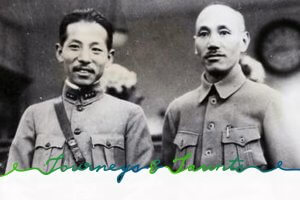
Once Chiang was free again, he had Zhang Xueliang put under house arrest, first in mainland China, then in Taiwan. The house arrest was only lifted after Chiang Kai-shek’s death in 1975. That’s a heck of a long ‘time-out’, don’t you think?
In the early 1990s, Zhang Xueliang and his mistress-turned-wife Edith Chao (赵一荻 in Chinese, zhào yīdí in pinyin) emigrated to Hawaii. It was there, in Honolulu to be exact, that Zhang Xueliang died of pneumonia about 3 months after his 100th birthday.
On the grounds of the Commander Zhang’s Mansion museum is an exhibition dedicated to Zhang Xueliang’s life. Only some of the titles of the explanation boards are in English, the rest is in Chinese. But having a look still makes sense, as there are many, many pictures and even if your Chinese is not perfect, you will be able to put together bits and pieces by looking at the dates mentioned.

Or maybe you’d like to take a guided tour through the entire mansion and the finance museum with Journeys & Jaunts? We will translate for you, and give you a lot of inside scoops on the people who lived there and the historical background. If you are interested in a tour, feel free to send an email to julie@journeysnjaunts.com.
3 courtyards
The oldest, and most traditional looking part of the Zhang residence is the three courtyards (called 三进院, or sān jìn yuan in pinyin). They are built in the traditional Chinese siheyuan style (also called courtyard house style in English), where the buildings form a quadrangle surrounding a courtyard.

Construction on this part of the complex was started in 1914, and the Zhang family moved into the courtyards in 1916.
They formed an entity of private residence and office buildings. Not only did the Zhang clan live here (including the various wives and offspring), but it was also the place where Zhang Zuolin received his subordinates, conducted talks with allies or enemies, and in general ran ‘his’ corner of the country.

You can still see this today by looking at the wax figures inside the buildings.
The courtyards have eleven buildings total and cover an area of just under 1800 square meters. They contained everything from a kitchen to a warehouse, to living quarters for the extended family, as well as general offices, reception halls, and more.

Some of the buildings show scenes of when the three courtyards were still inhabited by the Zhang family and teeming with soldiers, accountants, servants, etc. Others house exhibits from China’s early history and cultural relics from several different dynasties. Photography is not allowed in this part of the museum, so you will all have to go yourselves to discover them.
Signs for these exhibits are very comprehensive, but only in Chinese. So, again, if you want more information, you can book a tour with Journeys & Jaunts.
Da Qing Lou
The tallest structure of Commander Zhang’s Mansion is the one called the Big Blue-Green Building (大青楼 in Chinese, dà qīng lóu in pinyin). Supposedly, the stones are 青–colored, but I see neither blue nor green in them, they just look plain grey to me!
This building was constructed in 1922 and served as main office and private residence to both Zhang Zuolin and Zhang Xueliang and their families. Vastly different in style from the old-fashioned courtyards the families stayed in before, this structure is of neoclassical elegance.

At the time, Da Qing Lou was the highest building in Fengtian (today’s Shenyang) save the Phoenix Tower. From the lofty heights of its viewing platform up on the roof – unfortunately not open to modern-day visitors – one could overlook the entire city. And feel like a king surveying his realm. Which was the point, I guess.
Only the ground floor (1F in China) and the first floor (2F in China) are open to the public. But there are a number of handsomely appointed rooms and some exhibits to feast your eyes on.
On 1F, the following rooms can be admired by visitors: Zhang Zuolin’s office and his bedroom, the banquet hall, the tiger hall, and the office where the Northeast Administrative Committee held their meetings.
The office of the Old Marshal holds a massive desk and beautiful mural paintings by Cai Xiaopo. But the only piece of furniture the curators thought merited a separate sign is the wooden minifridge that apparently every Manchurian warlord needs!
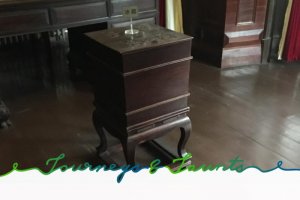
The Old Marshal’s bedroom is not all that fascinating. Small. And a bit bland. The most exciting thing to see there is all the loose change tourists have thrown onto the bedspread. Right next to the sign saying you should not throw any money in…
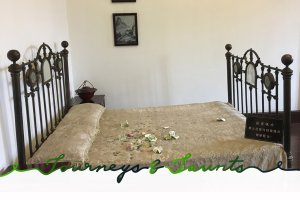
The reason for flinging coins onto historical artifacts is that these ‘donations’ are meant to bring good luck and fortune to the giver. Giving money to the spirit of Zhang Zuolin will supposedly make some of his good qualities rub off on you.
The banquet hall is better. It is where many of the alliances between the different factions in the warlord era were forged and the setting of the ‘Three Sons Talks’ which helped bring about victory for Zhang’s faction in the Second Zhili-Fengtian War. More interesting than some bed with change on it, don’t you think?
The room with the bloodiest history on this floor of Da Qing Lou is definitely the Tiger Hall. The room received its name due to the two taxidermized tigers standing creepily amongst the furniture. Why is its history bloody, you ask? It is in this room that both Zhang Zuolin and Zhang Xueliang would receive and entertain important guest.

And it is also in this room that the Young Marshal, on January 10th, 1929, that Yang Yuting (杨宇霆 in Chinese) and Chang Yinhuai (常荫槐 in Chinese) were assassinated (in what came to be known as the Yangchang Incident). Yang and Chang were his advisors and their pro-Japanese tendencies were a thorn in Zhang’s side. The assassination in front of other guests understandably shocked the entire country, but it also cemented Zhang Xueliang’s power.
The killing of Yang Yuting and Chang Yinhuai was not decided on a whim, apparently. The story goes that Zhang Xueliang, in the presence of his wife Yu Fengzhi (于凤至 in Chinese), tossed a coin that decided their fate. Right inside this building, in fact. In their living room, on 2F. There is even a table displaying the fateful coin on blood red velvet.

This floor also holds Zhang Xueliang’s office. Fun fact: To make sure everyone who needed to see him knew when to reach him, Zhang Xueliang not only put up his office hours on the door of his office. He actually went so far as to publish them in the newspaper, the Shenyang Times. Talk about an open calendar policy!
2F is also home to an exhibition entitled ‘General Zhang – relics of the later years.’ It proudly displays items that Zhang Xueliang used in the last years and months of his life while he lived in Hawaii. How about seeing the actual nail clippers of Zhang Xueliang? Or the wheelchair he used to get around? Or maybe the birthday candles on his 100th birthday cake? This exhibition has them all…

Another room open to visiting tourists on this floor is the Office of the Northeast Administrative Committee. This group with initially 13 members, headed by Zhang Xueliang, constituted the highest administrative organ for governing China’s Northeast from 1929 to 1931.
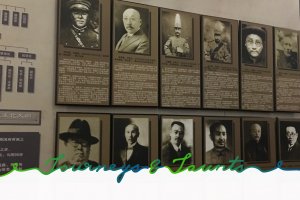
Xiao Qing Lou
Where there is Big Blue-Green Building, there has to be a Small Blue-Green Building (小青楼 in Chinese, xiǎo qīng lóu in pinyin) as well, right? Well, there is. Right in the middle of the garden area, in fact. Daintier than its big brother, Xiao Qing Lou only has two stories, and its architecture mixes Western and Chinese style elements.
The main structure looks Western, but many of the decorative design elements are Chinese. There are traditional carvings in the wood and stone work of the house, so pay close attention to the spaces above doors and windows.

This building actually predates its ‘big brother’, as it was constructed in 1918. Zhang Zuolin intended it as the sole living quarter for the 5th of his wives, Ms. Shou, who was his favorite. She lived there and, to appease the other jealous wives, gave them the best bedrooms in the house for their personal use, while she herself lived in the least attractive one.
The interested visitor can also see the room where the Old Marshal died after the bomb planted under a bridge near Huanggutun went off under his train carriage.

and called for the doctor to change the wound dressings even after he passed in order to deceive the Japanese Consul General’s wife, who was present. This way, the Japanese were unaware that Zhang Zuolin was dead, which in turn gave Zhang Xueliang the time he needed to seize power and get home for his father’s funeral. Otherwise, the Japanese might have used the Fengtian troops’ weakness and carried out a coup.
Guandi Temple
The small, private temple stuck in a corner of the garden area is dedicated to Guan Yu (关羽 in Chinese, guān yǔ in pinyin), a general-turned-deity that serves as a role model for many military men.
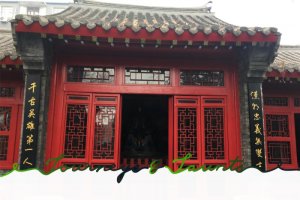
Zhang Zuolin greatly admired Guan Yu and had this three-room shrine built in his honor. The middle room holds a statue depicting Guan Yu, the right one has a sculpture of Zhang Zuolin himself (erected after his death). In the left room are a halberd, a tablet and a wall hanging.
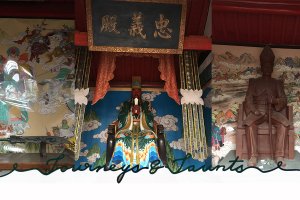
Ms. Zhao’s House
To get to Ms. Zhao’s house, one has to leave the area of the museum. Go through the turnstile and follow the throng of other tourists probably flocking east to the little red house which looks like this:

The strangest thing about this house is probably that it was commissioned by Yu Fengzhi, the official wife of Zhang Xueliang, for his mistress Edith Chao (赵一荻 in Chinese, zhào yīdí in pinyin). I consider myself a fairly open-minded and unjealous person, but building a house for my husband’s mistress is NOT something I would do. What about you?
Edith Zhao (along with Zhang Xueliang) lived in this small house from 1928 until 1930.
The outside of the house is fairly unremarkable, other than that it is covered in red plaster work. The inside is outfitted with French furniture and I found it fairly simple and pretty.

All the furniture, wall papers as well as the objects of daily use displayed there are reproductions or genuine antiques from the late 1920s. Since the house was put to other uses after the Zhang family vacated the premises, none of the original furniture in here survived.
Border Bank
Around the corner of Ms. Zhao’s House is the Border Bank (边业银行in Chinese, biān yè yínháng in pinyin), 95% of whose stock belonged to the Zhang family. This former private bank now houses the Shenyang Finance Museum.
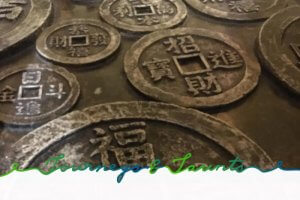
The house is fairly big and holds quite the comprehensive collection of old and new currencies, several showrooms with wax figures, an old treasury and much more. So much more, that it merits an article in its own right. Let me know in the comments or send a private message through the WeChat account if you want to know more about the Finance Museum.
Red brick buildings
There are seven buildings to the west of what tourists today can see when visiting Commander Zhang’s Mansion. They are made of red brick and were built in 1930 on the orders of Zhang Xueliang. The buildings combine Tudor and Gothic elements and are the biggest ones in all of the complex, being 3 stories tall.
These red brick buildings are not open to the public, but house offices dealing with the administration of the museum.
Location, opening hours and tickets
Are you curious about visiting Commander Zhang’s Mansion(click here for the pin)? It is located in Shenhe District, off Chaoyang Street. The address in Chinese is朝阳街少帅府巷46号 (cháo yáng jiē shǎo shuài fǔ xiàng 46 hào in pinyin).
The closest subway station is Middle Street (中街站 in Chinese, zhōngjiē zhàn in pinyin), then about a 300m walk south. Parking there is not ideal, so coming by cab or public transport is recommended.
The museum is open from 8:30-16:30 during ‘winter season’ (October 16th – April 30th), from 8:30-17:00 between May 1st and October 15th. On Mondays, the museum only opens from 13:00 onwards.
Tickets for the museum (including Ms. Zhao’s House and the Finance Museum inside the Border Bank) cost 60 RMB per adult or child over 1.3m. If you are between 60 and 69 years old or a middle, high school, or university student, you pay half price. Children smaller than 1.3m, the elderly (70 years of age and up), active military personnel and disabled people are free.
If you are interested in getting more information on a private tour by Journeys & Jaunts, contact us through the WeChat account or by sending an email to julie@journeysnjaunts.com





Pingback: Huanggutun Incident Museum | Journeys & Jaunts